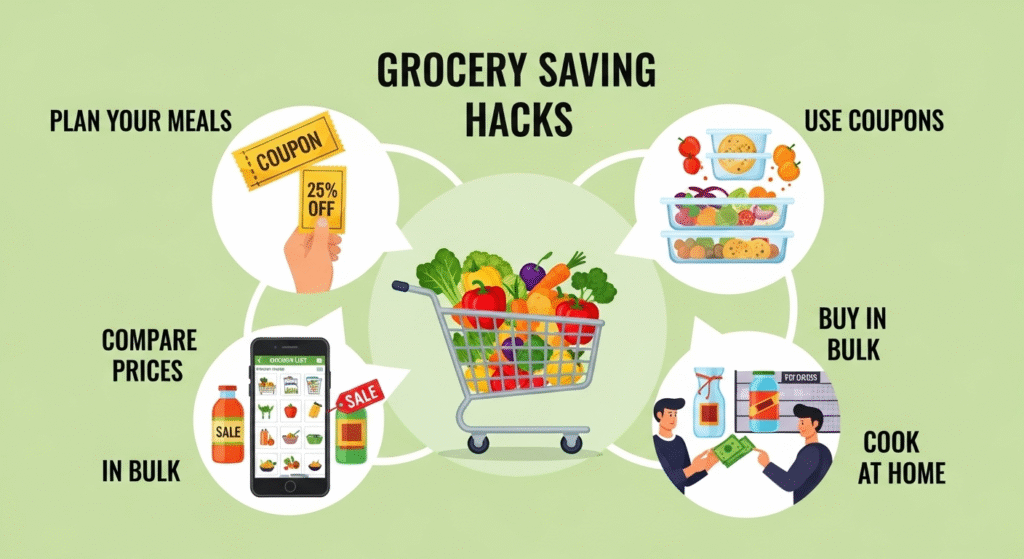
Grocery saving hacks are essential for anyone looking to reduce their food expenses without compromising on quality or nutrition. With rising grocery prices, finding smart ways to cut costs has become more important than ever. By implementing practical strategies, you can save money, avoid waste, and make your shopping trips more efficient.
In this guide, we will explore simple yet effective methods to slash your grocery bills in half. From meal planning and using coupons to buying in bulk and shopping seasonally, these grocery saving hacks will help you stretch your budget, shop smarter, and enjoy delicious meals without overspending.
Plan Your Meals Ahead
One of the most effective grocery saving hacks is planning your meals ahead of time. Meal planning helps you know exactly what you need for the week, reducing the chances of buying unnecessary items. When you plan meals, you can balance your diet, incorporate leftovers, and avoid the stress of last-minute decisions that often lead to expensive takeout or impulse buys.
Start by creating a weekly menu. List breakfasts, lunches, dinners, and snacks for each day. Take into account your family’s preferences, portion sizes, and any special occasions or events. Consider incorporating meals that share ingredients to minimize waste. For example, if you plan to make stir-fry one night, leftover vegetables can be used in a soup the next day.
Meal planning also helps reduce food waste. When you know what ingredients you have and what you will use, you can buy only what is necessary. Foods are less likely to expire before being consumed, saving money in the long run. Keep a notepad or app handy to track items you already have at home to avoid duplicates.
Make a Smart Shopping List
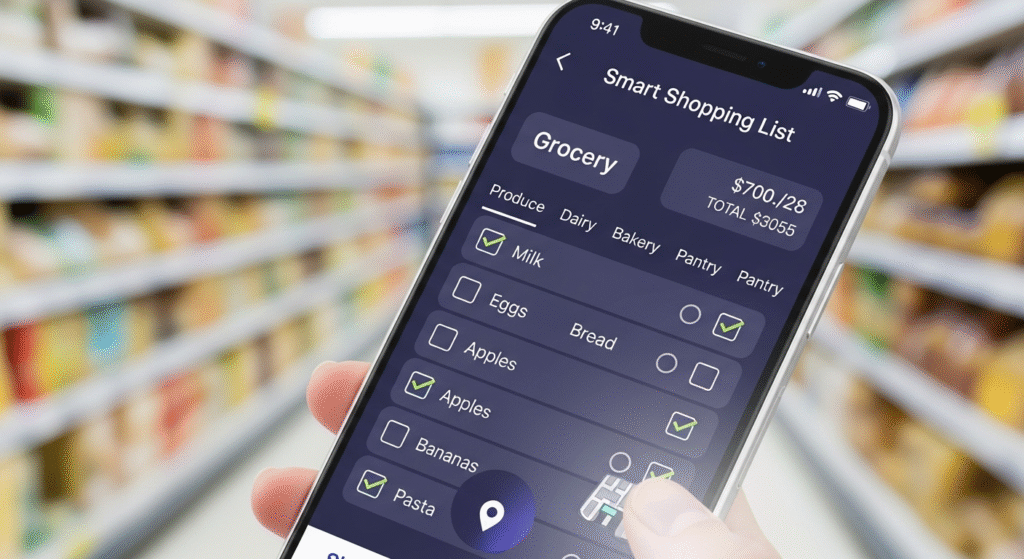
A smart shopping list is another essential grocery saving hack. Once you have your weekly menu planned, create a detailed shopping list based on the ingredients you actually need. Writing a list prevents impulse purchases, which are one of the biggest reasons grocery bills increase unexpectedly.
Organize your list by category, such as produce, dairy, meats, pantry items, and frozen foods. Categorization makes your shopping trip more efficient and ensures you don’t forget important items. You can also note the quantity required for each item to avoid overbuying, especially for perishables like fruits, vegetables, and bread.
Avoid shopping without a list. Walking through the aisles aimlessly often leads to picking up items you don’t need. Stick strictly to your list and resist any temptations, even if products are on sale. By focusing on what you need, you save both time and money while reducing food waste.
Use Coupons and Cashback Apps
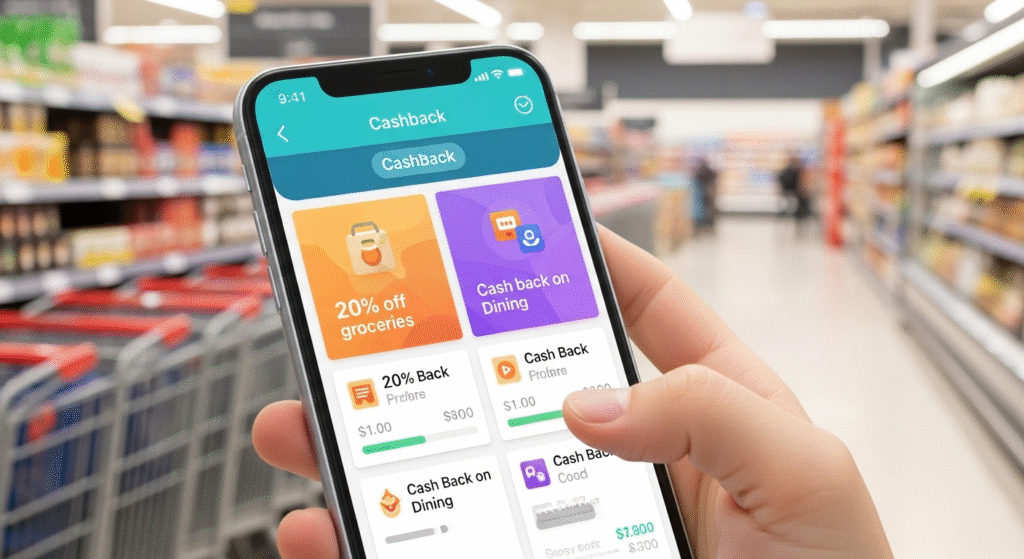
Coupons and cashback apps are practical grocery saving hacks that can help you cut costs significantly. Both digital and paper coupons provide instant discounts on your favorite items. Look for coupons in store flyers, websites, apps, or newspapers to maximize savings.
Cashback apps like Ibotta, Rakuten, or store loyalty programs offer additional money back for purchases. Many stores allow you to stack coupons with cashback offers, giving you the double benefit of discounts and cash rewards. Take the time to learn how each app works and link them to your payment methods to simplify the process.
Regularly checking for deals before shopping allows you to buy items on sale instead of paying full price. Combine coupons with weekly store promotions for maximum savings. This grocery saving hack is especially effective for high-ticket items or pantry staples like milk, cereal, and cleaning products.
Buy in Bulk and Store Properly
Buying in bulk is a smart grocery saving hack, but it must be done wisely. Bulk purchases often come at a lower price per unit, which can save money over time. Items like rice, pasta, canned goods, and cleaning supplies are ideal for bulk buying because they have a long shelf life.
Proper storage is crucial when buying in bulk. Use airtight containers, label expiration dates, and store items in a cool, dry place to maintain freshness. For perishable goods like meat, vegetables, and dairy, freezing in portions can prevent spoilage.
Avoid overbuying perishable items. Purchasing large amounts of fruits, bread, or dairy that spoil quickly can lead to waste, negating the savings. Focus on items that you use regularly and can store safely for weeks or months.
Shop Seasonal and Local Produce
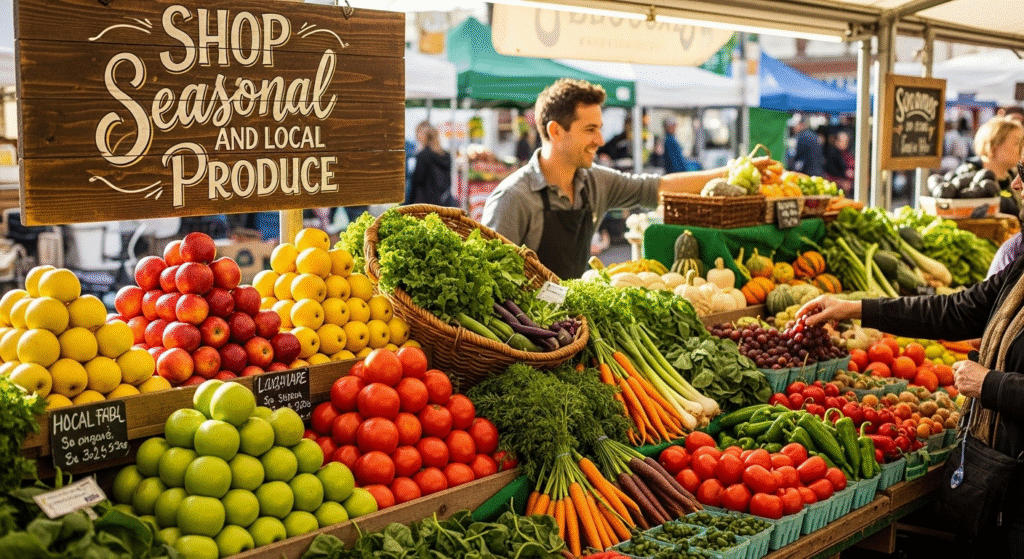
Shopping for seasonal and local produce is a valuable grocery saving hack. Seasonal fruits and vegetables are often cheaper, fresher, and tastier compared to out-of-season options that are imported or stored for long periods.
Local farmers’ markets provide high-quality produce at lower prices than supermarkets. Buying locally supports farmers and often ensures fresher products because the supply chain is shorter. Compare prices between local markets and grocery stores to find the best deals.
Seasonal shopping also allows you to adjust your meal plans according to what is available, saving money while adding variety to your diet. For instance, strawberries in spring are cheaper and sweeter than in winter when they are shipped from afar.
Compare Prices and Unit Costs
One of the most practical grocery saving hacks is comparing prices and unit costs before making a purchase. Many shoppers focus on the total price and overlook the cost per unit, which is often displayed on the shelf label. Checking the unit price helps you determine which brand or product offers the best value for money, whether it’s by ounce, pound, or liter.
Using store apps or websites makes price comparison even easier. Many retailers provide digital tools to help customers find discounts, check competitor prices, and locate deals in-store. Comparing prices online before shopping can save both time and money.
Another important tip is to consider store brands versus name brands. Store brands often provide the same quality as popular brands but at a lower price. Combining price comparison with unit checks ensures you get the most out of every dollar spent.
Avoid Shopping When Hungry
Shopping when hungry is a common mistake that increases grocery bills, and avoiding it is a key grocery saving hack. Hunger triggers impulse buying, leading you to pick snacks, ready-to-eat meals, or items that aren’t on your list. These unplanned purchases add up quickly, making it difficult to stick to your budget.
To prevent overspending, eat a meal or snack before heading to the store. This reduces cravings and keeps your mind focused on the items you actually need. Make a list in advance and commit to buying only those items.
Another tip is to shop during less busy hours, avoiding long lines and distractions. A clear mind and a full stomach are the best ways to implement this grocery saving hack and save money while shopping efficiently.
Freeze, Repurpose, and Reduce Waste
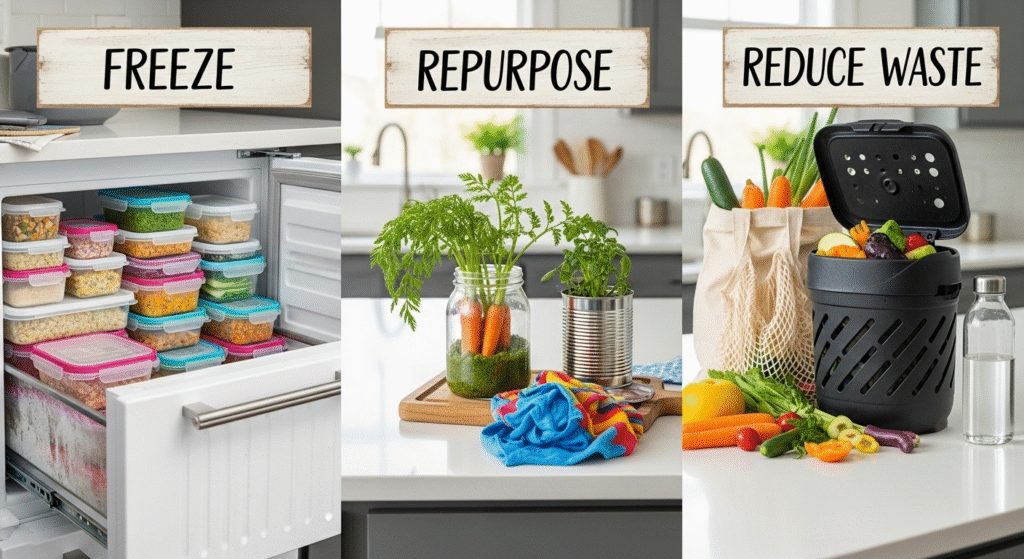
Freezing, repurposing, and reducing food waste are essential grocery saving hacks for anyone aiming to cut their monthly bills. Leftovers can be stored in airtight containers and frozen for future meals, preventing spoilage and unnecessary spending.
Bulk items that are perishable, like bread, meat, or vegetables, can also be frozen in portions to extend shelf life. Creative repurposing of food scraps, such as using vegetable stems for soups or stale bread for croutons, maximizes your groceries.
By reducing waste, you make every grocery dollar count. Planning meals around existing ingredients and storing food properly are simple yet effective grocery saving hacks that save money while promoting sustainability.
Take Advantage of Sales and Loyalty Programs
Timing purchases during sales and using loyalty programs are powerful grocery saving hacks. Stores frequently run promotions on seasonal items, pantry staples, or household products. Planning your shopping around these sales can lead to significant savings over time.
Store loyalty cards often provide additional discounts, personalized deals, and rewards points. Combine loyalty discounts with digital coupons or cashback offers for maximum benefit. Keep track of recurring sales and stock up on non-perishable items during promotions.
Using these strategies consistently ensures you spend less while still getting the items you need. This grocery saving hack is practical, simple, and effective for budget-conscious shoppers.
Track Your Grocery Spending
Tracking your grocery spending is an important grocery saving hack to ensure long-term savings. Keeping a budget allows you to monitor how much you spend weekly or monthly, identify patterns, and adjust habits to avoid overspending.
Use a notebook, spreadsheet, or budgeting apps to record every grocery expense. Compare actual spending to your planned budget and make necessary changes, such as reducing impulse purchases or choosing lower-cost alternatives.
By continuously monitoring your grocery spending, you gain control over your finances. This grocery saving hack encourages disciplined shopping habits, helps maintain a healthy budget, and ensures consistent savings over time.
Conclusion
Incorporating these grocery saving hacks into your shopping routine can make a significant difference in your monthly food expenses. From planning meals ahead, creating smart shopping lists, and using coupons, to buying in bulk, comparing prices, and avoiding impulse purchases, each strategy helps stretch your budget further. Freezing leftovers, repurposing food, and taking advantage of sales and loyalty programs add even more savings. Tracking your spending ensures you stay on target and adjust habits as needed. By consistently applying these practical tips, you can cut your grocery bills in half, reduce food waste, and enjoy a more organized, cost-effective, and stress-free shopping experience.
FAQs
What are the easiest grocery saving hacks for beginners?
For beginners, the easiest grocery saving hacks include planning meals ahead, making a shopping list, and sticking to it. Shopping with a budget, using coupons, and buying store brands instead of expensive name brands are also simple ways to save. Starting small with these practical strategies helps you develop disciplined habits, reduce impulse purchases, and gradually lower your monthly food expenses without feeling overwhelmed.
How can I avoid overspending on groceries?
Avoiding overspending starts with meal planning and sticking to a prepared list. Check unit prices, compare brands, and shop for seasonal or local produce. Use cashback apps, loyalty programs, and plan purchases around sales. Avoid shopping when hungry to reduce impulse buys. Tracking spending and reviewing your grocery budget regularly ensures that you stay on track. Implementing these grocery saving hacks consistently helps you save money while buying what your family truly needs.
Can using coupons really make a big difference?
Yes, using coupons can significantly lower your grocery bills. Look for both digital and paper coupons, combine them with store loyalty programs, and check for cashback offers. Coupons are especially effective when timed with sales or promotions, allowing you to purchase essential items at discounted rates. When used strategically, this method is one of the most effective grocery saving hacks for maximizing value while minimizing unnecessary spending.
Are there ways to reduce food waste and save money?
Reducing food waste is an essential grocery saving hack that directly saves money. Freeze leftovers, store perishable items properly, and repurpose scraps creatively. Plan meals around what you already have in your pantry to avoid overbuying. By organizing your fridge and using leftovers efficiently, you not only reduce waste but also stretch your grocery budget further. Small steps like these accumulate into significant monthly savings.
How important is tracking grocery expenses?
Tracking grocery expenses is crucial for financial awareness. Record all purchases, compare them to your budget, and analyze spending patterns. This helps identify areas for improvement, like cutting impulse buys or switching to cheaper alternatives. Regularly reviewing your spending allows you to implement effective grocery saving hacks, stay within budget, and maintain consistent savings. Tracking creates discipline and ensures your grocery shopping supports your overall financial goals.
How can buying in bulk help save money?
Buying in bulk is one of the most effective grocery saving hacks because it lowers the cost per unit for staple items like rice, pasta, or canned goods. Using bulk wisely, along with proper storage, ensures food stays fresh longer. Bulk shopping reduces trips to the store, saving both time and money. Combining bulk purchases with other grocery saving hacks, such as meal planning or using coupons, can significantly cut your overall monthly grocery expenses.
Are seasonal and local produce really cheaper?
Choosing seasonal and local produce is a smart grocery saving hack. Seasonal items are abundant and priced lower, while local markets offer fresh options at better rates than supermarkets. Using seasonal produce in meal plans helps minimize waste. Pairing this with other grocery saving hacks, like bulk buying or loyalty programs, can further maximize savings. Eating seasonally not only benefits your wallet but also ensures high-quality, nutritious, and flavorful meals for your family.
How do cashback apps and loyalty programs work?
Meal planning is a powerful grocery saving hack that prevents impulse purchases and reduces food waste. Planning meals weekly ensures you buy only what you need, while taking advantage of sales, seasonal produce, and bulk items. Meal planning works best when combined with other grocery saving hacks, like coupons and cashback apps, for maximum savings. Consistently applying these strategies helps control grocery spending, ensures nutritious meals, and creates an organized, cost-effective shopping routine.